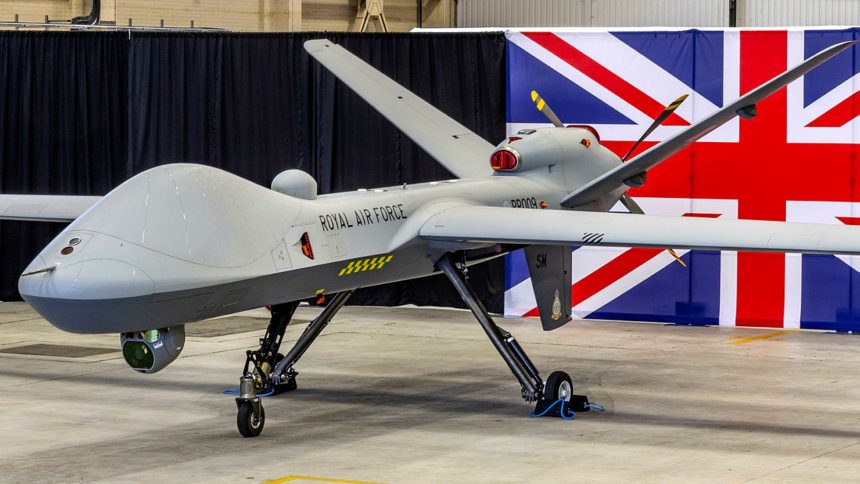The UK’s Ministry of Defence is currently examining a variant of the MQ-9B SkyGuardian to replace the Merlin HM2 Airborne Surveillance and Control aircraft.
In a written parliamentary question submitted on May 12, 2025, Conservative MP Ben Obese-Jecty, asked the UK’s Secretary of State for Defence about the assessment of the “feasibility of using the General Atomics MQ-9 for Royal Navy carrier based operations.”
On May 19, Defence Minister Maria Eagle answered the question, stating:
“Through the MQ-9 International Cooperation Support Partnership, of which the United Kingdom is a signatory, the Royal Navy (RN) has established that the General Atomics MQ-9 can be modified to operate from the Queen Elizabeth Class carriers. As such, the MQ-9 is being considered as a candidate for the RN’s requirement for Carrier Strike Airborne Early Warning following the planned withdrawal of the Crowsnest Airborne Early Warning system when it reaches the end of its service life.”
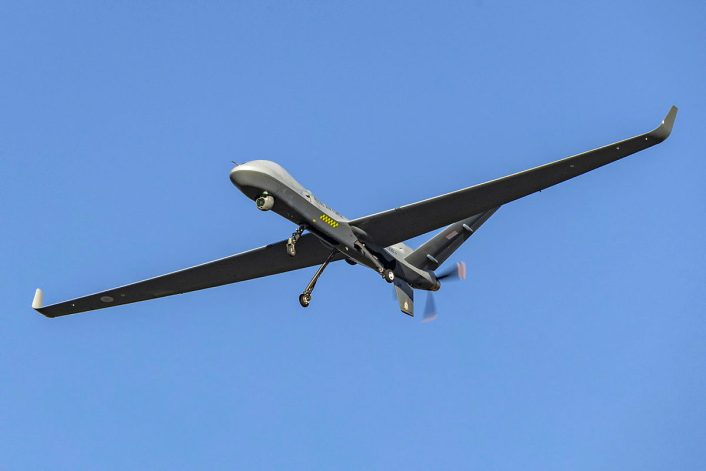
This suggests that the MQ-9B is one of many Unmanned Aerial Systems (UAS) that is currently being evaluated to replace Crowsnest in Airborne Early Warning and Control (AEW&C) role; it is certainly the most visible platform under consideration.
Previously, on Apr. 9, the Ministry of Defence published a request for information (RFI) from industry partners titled “Carrier Strike Airborne Early Warning Initial Market Engagement”. The objective of the RFI was to understand the “capacity and capability” of industry to support the development and production of an AEW&C system capable of operating from the Queen Elizabeth Class Aircraft Carriers and providing persistent 24 hours surveillance. The objective is for the system to provide a carrier strike group (CSG) with warning of air and surface threats, such as anti-ship guided weapons and strike aircraft, to allow for effective counter threat action.
The Ministry of Defence has confirmed that the General Atomics MQ-9B is being evaluated as a potential carrier-based airborne early warning (AEW) platform for the Royal Navy.https://t.co/ijvelf1zsb
— UK Defence Journal (@UKDefJournal) May 19, 2025
The Royal Navy is in desperate need for a replacement capability due to failures of Crowsnest, the Merlin helicopter-borne Airborne Surveillance and Control (ASaC) system. Off the shelf Short Take Off and Landing (STOL) UAS are the preferred option, due to their higher service ceilings. This increases the distance from the radar to the horizon line, meaning that the higher the radar is in the sky the further its radar can search, thus improving the overall radar coverage.
For example the Protector RG1 has a service ceiling of 40,000 ft, compared to the Merlin/Crowsnest which can only fly as high as 15,000 ft, allowing it a better radar detection range. Moreover, the Royal Navy would like an extended loiter time of over 24 hours offered by Medium Altitude Long Endurance (MALE) UAS, something that no helicopter can currently achieve.
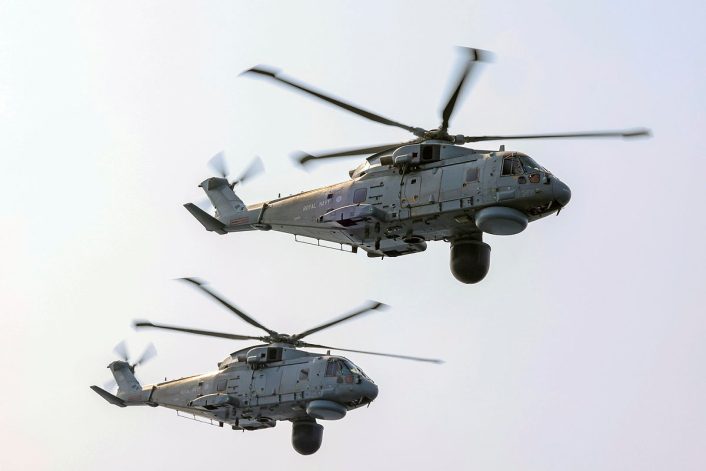
The major difference between UAS AEW&C against helicopter or aircraft borne systems is that the mission crew of Weapon Systems Officers (WSO), Air Traffic Controllers (ATC) and Operations Officers, who analyse the radar information and direct the response, will be based on the aircraft carrier or at a shore establishment, instead of being aboard the aircraft. Their interpretation of the radar returns and ATC orders will then have to be data linked to whatever aircraft are in the air so that they can then respond to any threat.
If the crew are shipborne, this will require the fitting of extra equipment on board the carrier to operate the UAS from its deck. Initial entry into service of the new AEW&C system is anticipated between 2030 and 2035, whilst Crowsnest leaves service in 2029, adding the possibility of a critical capability gap. Overall, the project has a very broad cost envelope, estimated between £0.5 and £1.5 billion, likely decided by how much research and development is required for the system before its entry into service. With the RQ-9B as a possible answer, this could be mostly an off-the-shelf capability insertion.
Helicopter AEW in the Royal Navy
The Royal Navy has been conducting the AEW&C mission with helicopters since 1982. Previously, the Navy had used fixed wing aircraft in the form of the Fairey Gannet, but these were removed from service alongside their carrier HMS Ark Royal (R09) in 1978. When the fleet sailed to the Falklands four years later, they were without this sorely needed capability and,, as a result, losses in ships, men and material were sustained.
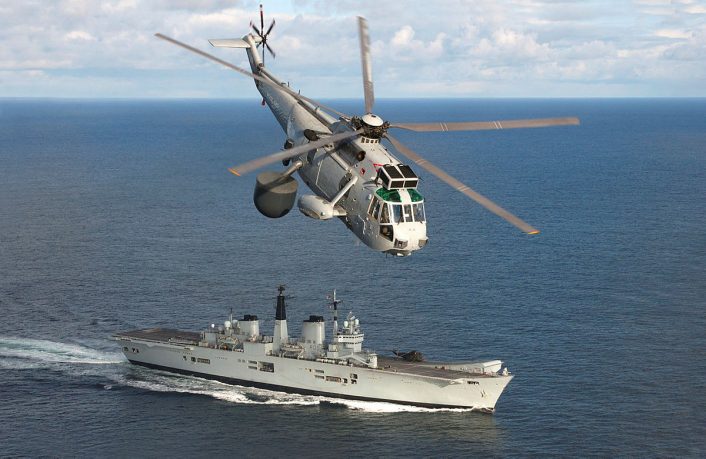
This could have been avoided in part with some critical warning time that an AEW&C aircraft could provide. The Royal Navy desperately needed warning against Argentine Exocet and bombing attacks conducted by their Etendard and Skyhawk fighter bombers, which had sunk six warships and damaged many others. As a result, back in the UK a crash program was set up to produce an AEW&C helicopter in eleven short weeks.
What emerged were initially two anti-submarine Sea King helicopters rapidly fitted with Thorn EMI Searchwater radar systems taken from RAF Nimrod MR2 maritime patrol aircraft (MPA), which could provide rudimentary early warning of incoming aircraft and missiles. The radar is mounted in an inflatable bag on the side of the helicopter and can be raised by rotating through 90º for landing. These aircraft would be colloquially known as the ‘baggers’, owing to those bags. Unfortunately, these helicopters arrived late for the conflict on board HMS Illustrious as she sailed rapidly to reinforce the British presence after hostilities had ended.
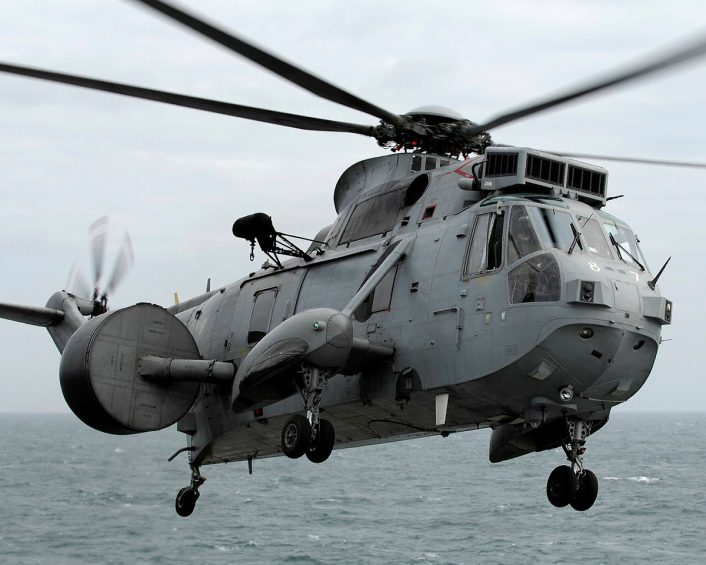
The quick fix soon became a permanent fixture of the Sea King, with a number of aircraft upgraded becoming the Sea King AEW2 from 1985 onwards. They would provide the Royal Navy with 33 years of continuous service until the Sea King ASaC7 variant was retired in 2018. By the time that the Sea King retired, the radar had gone through numerous upgrades, extending the detection range and improving their resolution, resulting in the Searchwater 2000 which would go into the Crowsnest.
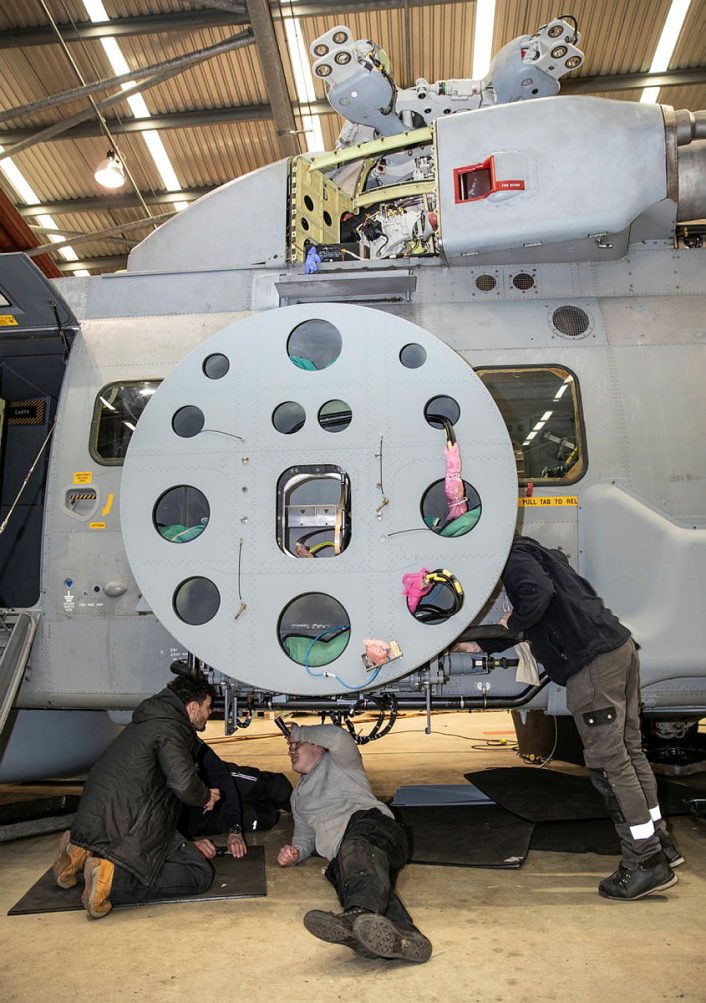
Crowsnest, the system that sought to replace the Sea King-borne AEW&C system, has been nothing but troublesome since it was introduced into the naval service around 2018. Initially meant to be an easy off the shelf replacement for the dedicated AEW Sea King, Crwosnest became a bolt-on package for the 30 existing Merlin HM2 anti-submarine (ASW) helicopters. This meant that radars and equipment could be swapped around as needed amongst the fleet, but this would instead run down an already depleted helicopter fleet and cause fleet availability issues in the 2020s.
Royal Navy Merlin Airborne Surveillance and Control (ASaC) Helicopter “Bagger” taken @RNASCuldrose viewing enclosure.#Crowsnest @LockheedMartin @RoyalNavy @faaoa @FAA_RN @Combat_Journal @AFMonthly #Bagger pic.twitter.com/wgQJPMn07u
— Bob Sharples (@JetPhots) April 22, 2021
The £269 million contract awarded to Lockheed Martin aimed to combine the Searchwater 2000 radar and the Cerberus Mission System software that controls the radar and links it to the helicopter’s own systems. The pilot seated up front would be joined by two observers in the back of the aircraft that use the Cerberus mission system to interpret the radar picture and coordinate other aircraft.
However, this has not worked out, with the price tag having increased to £425.7 million by December 2023, and with full operational capability (FOC) still not achieved despite the deployment of the Crowsnest on two full fledged carrier strike groups in 2021 and 2025. Information on the performance shortfalls is classified, but they are believed to be primarily related to software bugs severely limiting the performance of the entire system. There have been multiple patches to the software since the 2021 CSG, however improvements are limited.
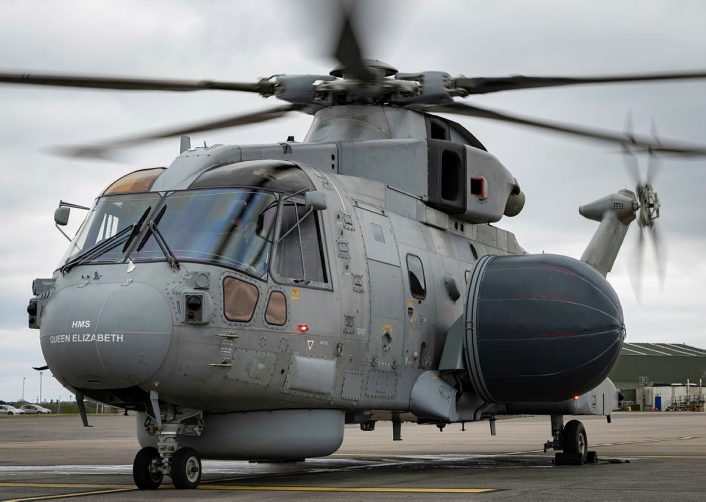
The Crowsnest’s out of service date of Dec. 31, 2029, issued before the system has even achieved FOC, highlights how little faith the Royal Navy and the wider Ministry of Defence have with the system, explaining the reinvigorated hunt for a replacement. Additionally, with the possibility of peer to peer conflict growing, along with the increased threat of hostile submarines sabotaging critical undersea infrastructure, the Royal Navy desperately needs its dedicated sub hunting helicopters back.
Mojave
On Nov. 15, 2023, a variant of the General Atomics Aeronautical Systems (GA-ASI) MQ-1C Grey Eagle called ‘Mojave’ successfully took off from and landed on the deck of HMS Prince of Wales, showing that the use of a MALE UAS from the deck of a carrier was possible. The variant in question had been developed for STOL, featuring a wing with a larger surface area to generate greater lift during take off.
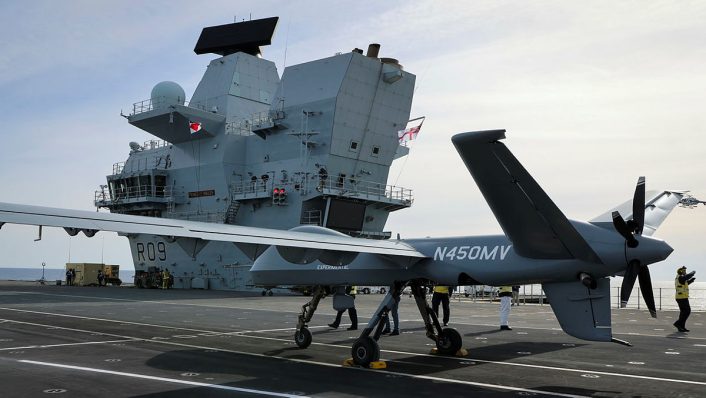
With a 17 m wingspan, the UAS is 6 m wider than an F-35B Lightning stealth fighter, and weighs 1.5 tons in its fully loaded configuration. For the test the UAS was controlled by a ground station set up on board the ship, with the drone itself taking off to the left side of the carrier’s ski ramp.
GA-ASI and @RoyalNavy made aviation history by launching and recovering #MojaveUAS aboard @HMSPWLS.
Mojave is the first UAS in its class to take off and land on the flight deck of a naval warship, redefining what’s possible for UAS operating at sea.
➡️https://t.co/GPW0s0V841 pic.twitter.com/dgs0RsLq41
— General Atomics Aeronautical Systems, Inc (GA-ASI) (@GenAtomics_ASI) December 11, 2023
This proof of concept demonstrated to the Royal Navy that it was possible to use a Remotely Piloted Air System (RPAS), from a Queen Elizabeth Class aircraft carrier and has led to new interest in drone platforms operating from the warship type. Given the utility of RPAS such as the MQ-9A Reaper demonstrated during the Global War On Terror (GWOT), which performed extremely well in the Intelligence, Surveillance, Target Acquisition and Reconnaissance (ISTAR) role, deployment from a carrier seems a useful next step.
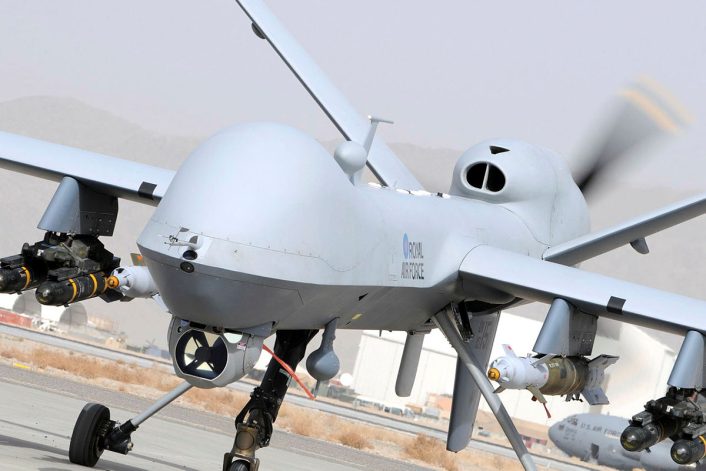
Unlike the US and French aircraft carriers, the Queen Elizabeth class lacks a catapult, meaning that heavy conventional AEW&C aircraft such as an E-2 Hawkeye cannot take off from British carriers. As a result, a STOL RPAS that can make up for the deficiencies of Crowsnest is the best choice for the Royal Navy, if it can be worked out. One of the main technical challenges presented by this requirement is the weight, and whether a light platform such as a drone can carry a radar large enough to be useful and still take off under its own power. Hopefully the defence industry is up to this challenge.
📸 Red Sea 📍 US Navy E-2 Hawkeye (tactical airborne early warning aircraft) & F-18’s taking off from USS Eisenhower carrier a few hours ago. pic.twitter.com/T450XBKvdE
— MenchOsint (@MenchOsint) January 12, 2024
Protector
The main contender that has been stressed by the MOD and Defence Minister Maria Eagle is the Protector RG Mk 1 MQ-9B. Officially the successor to the Reaper MQ-9A, which was itself an urgent operational requirement pressed into service during the GWOT, Protector features several advancements over Reaper. This includes the ability to autonomously land and take off, reducing the need for deployed personnel overseas controlling the system during this process, which was a key feature of the Reaper and Predator platforms. Protector can also operate in civilian airspace thanks to ‘detect and avoid’ technology, opening up a field of operations for the RPAS.
Entering Royal Air Force service in 2024, the aircraft joined No. 31 Squadron ‘The Goldstars’, with 16 airframes currently planned for service, although the option for further orders is available. Protector can carry an array of ordinance, including British made Brimstone II and Paveway IV smart munitions, whilst also carrying an on board High-Definition Electro-Optical, Infra-Red (IR) camera for surveillance purposes. These aircraft have already been pegged for maritime surveillance duties, taking pressure off the Poseidon MPA whilst it fulfils its traditional duties of close air support and long range ISTAR. Most importantly, its ability to fly for up to 40 hours without refuel makes it an intriguing option for an updated AEW role.
MQ-9B STOL acting as an AEW aircraft for the Royal Navy Carrier Air Wing, a thread of imagery🧵. pic.twitter.com/Ijz7ZC3sqL
— David (@Davidfrigate) May 13, 2025
Combined with the STOL kit demonstrated by Mojave and a modern air surveillance radar, the Protector could make an ideal platform to fix the current struggles that the Royal Navy is facing.
The Royal Navy had planned for an autonomous system to take the reins of AEW, with Project Vixen laying out plans for a stealthy catapult-launched drone of design similar to the MQ-28 Ghost Bat. However, this project was put on the backburner seemingly one year ago, with upgrades to HMS Queen Elizabeth prioritising the installation of lighting arrays to facilitate Short Rolling Vertical Landing (SRVL) for aircraft on board.
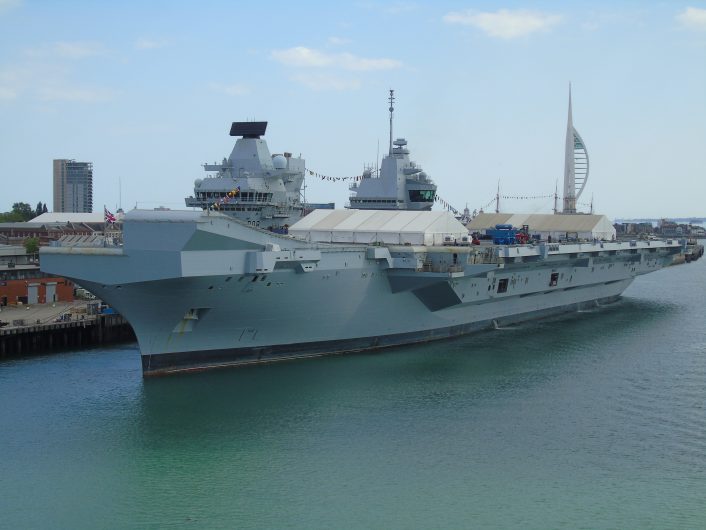
Whilst primarily useful for the RAF’s F-35B Lightning fleet, ensuring that they can land with higher weight limits, SRVL could be useful for the controlled landing of RPAS onto the deck of the carrier. During standard operations from shore bases, Protector uses autonomous landing and take-off systems, however the added complications of carrier landings may require a ground station to handle the coming and going of RPAS from the carrier itself. This could further indicate the desire of the Royal Navy for a STOL variant of the MQ-9B for service on board, but this is currently speculation.
As it stands, the Royal Navy and industry partners will have 5 years to take a design from the drawing board to entry into service. This is a tall order for the types of upgrades needed for the Protector RPAS and the Queen Elizabeth class carriers to get this hypothetical system to function. But, if the Royal Navy in 1982 could do it in eleven weeks, perhaps it can do it after all. Only time will tell.

